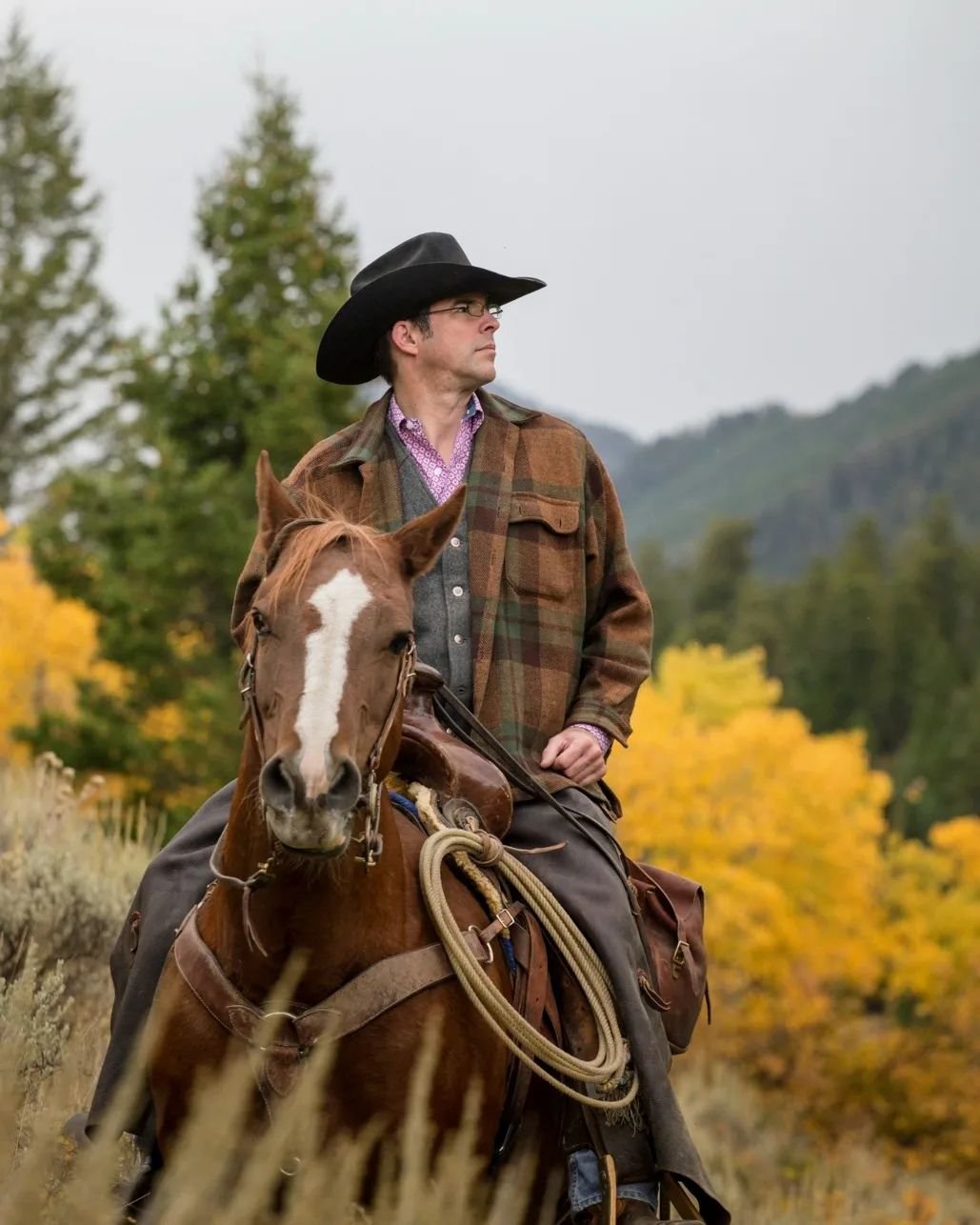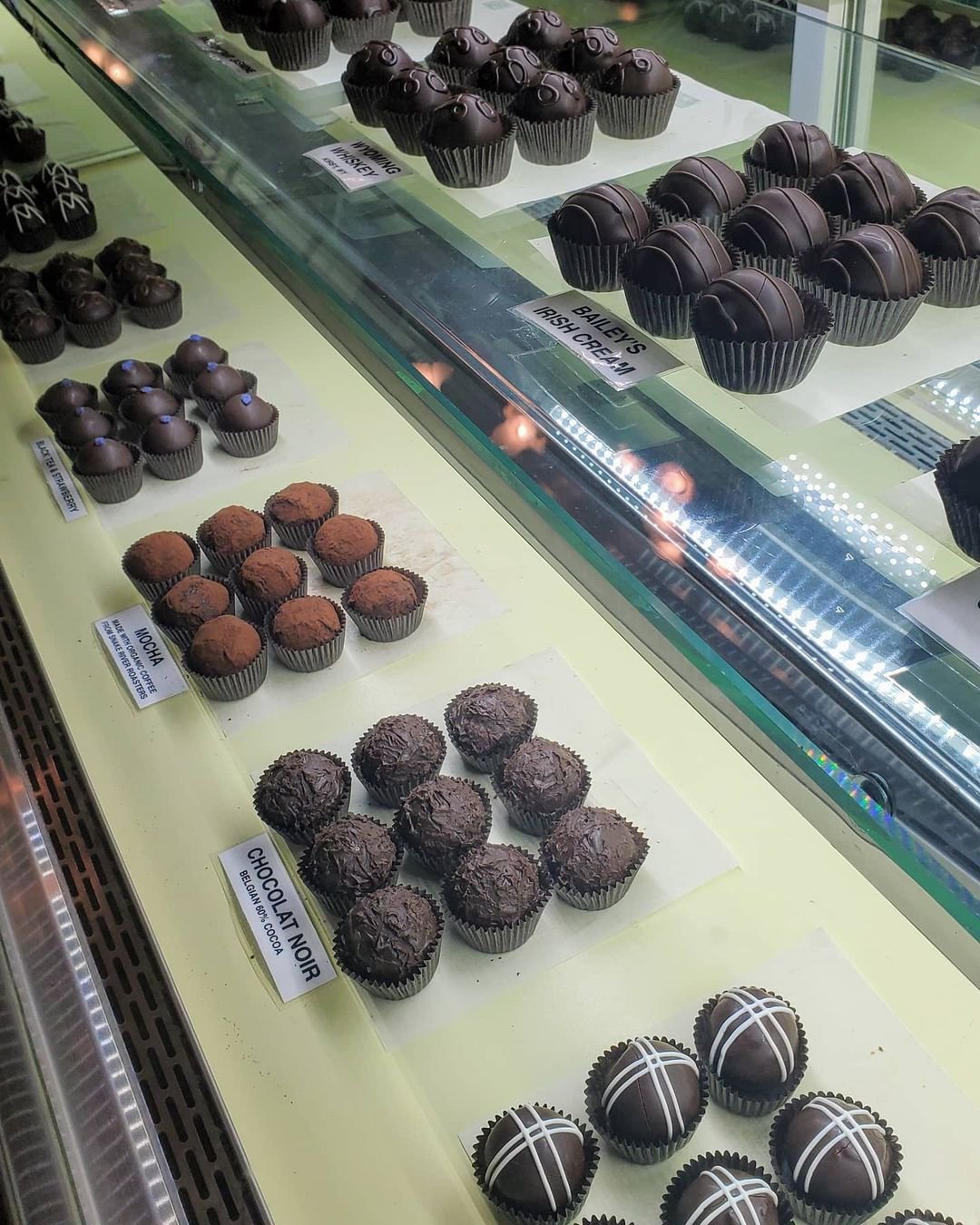
Tim Kellogg, who formerly competed in rodeos as a saddle bronc rider and known professionally as the Meeteetse Chocolatier, started selling chocolates in 2004 to pay for a new saddle. (Courtesy photo from Tim Kellogg)
Meeteetse Chocolatier thrills in creating new flavor combinations
CODY, Wyo. — A cowboy astride a bucking horse has been an iconic representation of Wyoming for more than a century—at least since 1921, when that silhouette first graced uniforms for baseball players at the University of Wyoming. And chocolate has been connected to Valentine’s Day since 1861, when Richard Cadbury sold heart-shaped boxes of chocolate candies adorned with roses and Cupids.

Tim Kellogg’s retail display case offers a range of chocolate truffles and other hand-crafted confections. (Courtesy photo from Tim Kellogg)
Those elements converge today — Valentine’s Day — when Tim Kellogg, known professionally as the Meeteetse Chocolatier, will almost certainly sell out his inventory of hand-crafted truffles, pastries and other confections on one of his busiest days of the year.
Kellogg, a former rodeo saddle bronc rider, first sold his chocolates in 2004 to raise money for a new saddle. He has since bought a downtown storefront in tiny Meeteetse (home to approximately 300), shipped his products around the world and been profiled in the New York Times.
He still loves riding horses, and routinely wears Wranglers, cowboy boots, a silver belt buckle and a black cowboy hat. But Kellogg is far more famous now for his culinary creations than his exploits coming out of the bucking chutes.
Kellogg reflected on his unlikely path from ranch hand and rodeo rider to globetrotting chocolatier last week after pulling an all-nighter to make hundreds of bourbon-infused truffles for Wyoming Whiskey as part of the company’s Valentine’s Day promotions.
“I do better when I’m challenged,” he said, and custom orders are especially fun because he enjoys creating something completely new.
Working all night to create a new confection is a thrill that “has kind of replaced rodeo and that rush you have when the gate opens and the horse jumps out,” he said.
Kellogg learned chocolate making from his grandmother and mom, and kept his enterprise small at first. He made and sold chocolates on Saturdays while working at a ranch the rest of the week. Kellogg used profits from each week’s sales to fund the next week’s efforts, bootstrapping the business as he went and eventually working full time as a chocolate maker.
Learning new techniques and developing new recipes wasn’t easy in such a remote, isolated place.
“I got to this point where everything wasn’t growing, and I didn’t know how to grow myself or grow the business in breadth or diversity,” he said, adding that artisanal chocolate shops in the U.S. were rare, and a world away.
An unlikely breakthrough
But a breakthrough came for Kellogg while working one winter at a 10,000-acre Meeteetse cattle ranch. The job allowed him to browse an online subscription to The Sunday Times of London, a newspaper that featured recipes and chef profiles drawn from the city’s burgeoning high-end chocolate scene.
“I’d go to work in the evening and stay overnight when the cows were giving birth,” he said. “They had a computer and a little office in the heated part of the barn, and I would go out every 30 or 40 minutes and walk through the herd and make sure everything was OK, then go back in and go online to learn more about chocolate.”

The sign for the Meeteetse Chocolatier storefront features a rider astride a bucking horse, an icon for the state of Wyoming and coincidental visual shorthand for the company’s founder, former rodeo saddle bronc rider Tim Kellogg. (Courtesy photo from Tim Kellogg)
Approximately 12 years ago, Kellogg traveled to London for a chocolate-making course, and has returned once or twice each year, sometimes working as an unpaid apprentice for Europe’s most prestigious chocolatiers.
At one point, he worked with a Belgian instructor who had Kellogg sample chocolates paired with different cheeses or foie gras (not his favorite food), and make savory dishes like a chicken breast smoked with tea leaves.
Frustrated with the odd lessons and ready to quit, Kellogg paused while walking past a London bakery, stopping to see (and smell) an elaborate display of focaccia bread.
“I love focaccia—the rosemary and olive oil and sea salt—and I remembered making a rosemary cream sauce” the day before for the chocolate apprenticeship. “Then it hit me. What if I made a ganache with those focaccia flavors?”
That epiphany helped break Kellogg out of what he said had been a linear and tunnel-vision approach to making chocolate.
He has also expanded his Europeans studies to include patisserie, a dizzying and picture-perfect selection of which he offers at his retail outlet.
Since then, Kellogg also travels to Belize for a week or two each year to meet with cacao farmers and learn every step of how chocolate’s central ingredient is raised and processed. It’s important for Kellogg to source cacao directly from environmentally conscious growers.
With a commodity like cacao, buying direct offers small family farmers a much higher margin, a concept many Wyoming cattle ranchers are working to implement with consumers and restaurants.
That requires educating people about why hand-made chocolate produced from single-origin cacao costs more than convenience store candy, Kellogg said, something most of his customers now understand. They also know to shop early.
He often sells out by mid-afternoon during the tourist season, and typically doesn’t ship during the hotter months. Kellogg only produces as much product as he expects to sell, working alone to create confectionary perfection with a recommended shelf-life of less than a week.
For Kellogg, trying new ingredients and creating unexpected flavor combinations helps keep his work interesting. But he’s also hanging on to old favorites like his focaccia truffle, which isn’t always a best-seller, but remains a cult favorite for many longtime customers.
“I always keep that one in my display case,” he said. “I keep it in there as a reminder to myself of what was, and what can be.”
Reprinted with permission from the Wyoming Truth.

Why isn’t there a link to an online source where we can purchase the chocolates?
Sandy, try meeteetsechocolatier.com